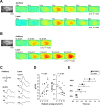Auditory cortical activity elicited by infrared laser irradiation from the outer ear in Mongolian gerbils
- PMID: 33057339
- PMCID: PMC7561108
- DOI: 10.1371/journal.pone.0240227
Auditory cortical activity elicited by infrared laser irradiation from the outer ear in Mongolian gerbils
Abstract
Infrared neural stimulation has been studied for its potential to replace an electrical stimulation of a cochlear implant. No studies, however, revealed how the technic reliably evoke auditory cortical activities. This research investigated the effects of cochlear laser stimulation from the outer ear on auditory cortex using brain imaging of activity-dependent changes in mitochondrial flavoprotein fluorescence signal. An optic fiber was inserted into the gerbil's ear canal to stimulate the lateral side of the cochlea with an infrared laser. Laser stimulation was found to activate the identified primary auditory cortex. In addition, the temporal profile of the laser-evoked responses was comparable to that of the auditory responses. Our results indicate that infrared laser irradiation from the outer ear has the capacity to evoke, and possibly manipulate, the neural activities of the auditory cortex and may substitute for the present cochlear implants in future.
Conflict of interest statement
The authors have declared that no competing interests exist.
Figures



References
Publication types
MeSH terms
LinkOut - more resources
Full Text Sources

